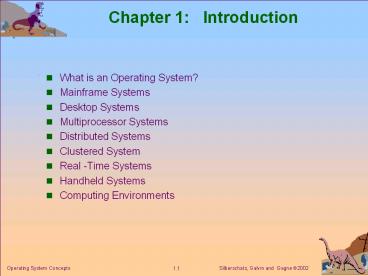Chapter 1: Introduction - PowerPoint PPT Presentation
1 / 24
Title:
Chapter 1: Introduction
Description:
Chapter 1: Introduction What is an Operating System? Mainframe Systems Desktop Systems Multiprocessor Systems Distributed Systems Clustered System – PowerPoint PPT presentation
Number of Views:585
Avg rating:3.0/5.0
Title: Chapter 1: Introduction
1
Chapter 1 Introduction
- What is an Operating System?
- Mainframe Systems
- Desktop Systems
- Multiprocessor Systems
- Distributed Systems
- Clustered System
- Real -Time Systems
- Handheld Systems
- Computing Environments
2
What is an Operating System?
- A program that acts as an intermediary between a
user of a computer and the computer hardware. - Operating system goals
- Execute user programs and make solving user
problems easier. - Make the computer system convenient to use.
- Use the computer hardware in an efficient manner.
3
Computer System Components
- 1. Hardware provides basic computing resources
(CPU, memory, I/O devices). - 2. Operating system controls and coordinates
the use of the hardware among the various
application programs for the various users. - 3. Applications programs define the ways in
which the system resources are used to solve the
computing problems of the users (compilers,
database systems, video games, business
programs). - 4. Users (people, machines, other computers).
4
Abstract View of System Components
5
Operating System Definitions
- Resource allocator manages and allocates
resources. - Control program controls the execution of user
programs and operations of I/O devices . - Kernel the one program running at all times
(all else being application programs).
6
Mainframe Systems
- Reduce setup time by batching similar jobs
- Automatic job sequencing automatically
transfers control from one job to another. First
rudimentary operating system. - Resident monitor
- initial control in monitor
- control transfers to job
- when job completes control transfers pack to
monitor
7
Memory Layout for a Simple Batch System
8
Multiprogrammed Batch Systems
Several jobs are kept in main memory at the same
time, and the CPU is multiplexed among them.
9
OS Features Needed for Multiprogramming
- I/O routine supplied by the system.
- Memory management the system must allocate the
memory to several jobs. - CPU scheduling the system must choose among
several jobs ready to run. - Allocation of devices.
10
Time-Sharing SystemsInteractive Computing
- The CPU is multiplexed among several jobs that
are kept in memory and on disk (the CPU is
allocated to a job only if the job is in memory). - A job swapped in and out of memory to the disk.
- On-line communication between the user and the
system is provided when the operating system
finishes the execution of one command, it seeks
the next control statement from the users
keyboard. - On-line system must be available for users to
access data and code.
11
Desktop Systems
- Personal computers computer system dedicated to
a single user. - I/O devices keyboards, mice, display screens,
small printers. - User convenience and responsiveness.
- Can adopt technology developed for larger
operating system often individuals have sole use
of computer and do not need advanced CPU
utilization of protection features. - May run several different types of operating
systems (Windows, MacOS, UNIX, Linux)
12
Parallel Systems
- Multiprocessor systems with more than one CPU in
close communication. - Tightly coupled system processors share memory
and a clock communication usually takes place
through the shared memory. - Advantages of parallel system
- Increased throughput (though not linear speedup)
- Economical (share peripherals, system components)
- Increased reliability
- graceful degradation
- fail-safe systems
13
Parallel Systems (Cont.)
- Symmetric multiprocessing (SMP)
- Each processor runs and identical copy of the
operating system. - Many processes can run at once without
performance deterioration. - Most modern operating systems support SMP
- Asymmetric multiprocessing
- Each processor is assigned a specific task
master processor schedules and allocated work to
slave processors. - More common in extremely large systems
14
Symmetric Multiprocessing Architecture
15
Distributed Systems
- Distribute the computation among several physical
processors. - Loosely coupled system each processor has its
own local memory processors communicate with one
another through various communications lines,
such as high-speed buses or telephone lines. - Tightly coupled system share clock
- Advantages of distributed systems.
- Resources Sharing
- Computation speed up load sharing
- Reliability
- Communications
16
Distributed Systems (cont)
- Requires networking infrastructure.
- Local area networks (LAN) or Wide area networks
(WAN) - May be either client-server or peer-to-peer
systems.
17
Network OS
- Similar to Distributed OS
- Distributed OS unified system view
- Network OS user is aware of distributed nature
of system (e.g. naming of resources for printing)
18
General Structure of Client-Server
19
Clustered Systems
- Clustering allows two or more systems to share
storage. - Provides high reliability (e.g. web servers,
airlines) - Asymmetric clustering one server runs the
application while other servers standby. - Symmetric clustering all N hosts are running the
application.
20
Real-Time Systems
- Often used as a control device in a dedicated
application such as controlling scientific
experiments, medical imaging systems, industrial
control systems, and some display systems. - Well-defined fixed-time constraints.
- Real-Time systems may be either hard or soft
real-time
21
Real-Time Systems (Cont.)
- Hard real-time
- Guarantees time constraints
- Secondary storage limited or absent, data stored
in short term memory, or read-only memory (ROM) - Conflicts with time-sharing systems, not
supported by general-purpose operating systems. - Soft real-time
- Limited utility in industrial control of robotics
- Useful in applications (multimedia, virtual
reality) requiring advanced operating-system
features.
22
Handheld Systems
- Personal Digital Assistants (PDAs)
- Cellular telephones
- Issues
- Limited memory
- Slow processors
- Small display screens.
23
Migration of Operating-System Concepts and
Features
24
Computing Environments
- Traditional computing
- Web-Based Computing
- Embedded Computing































